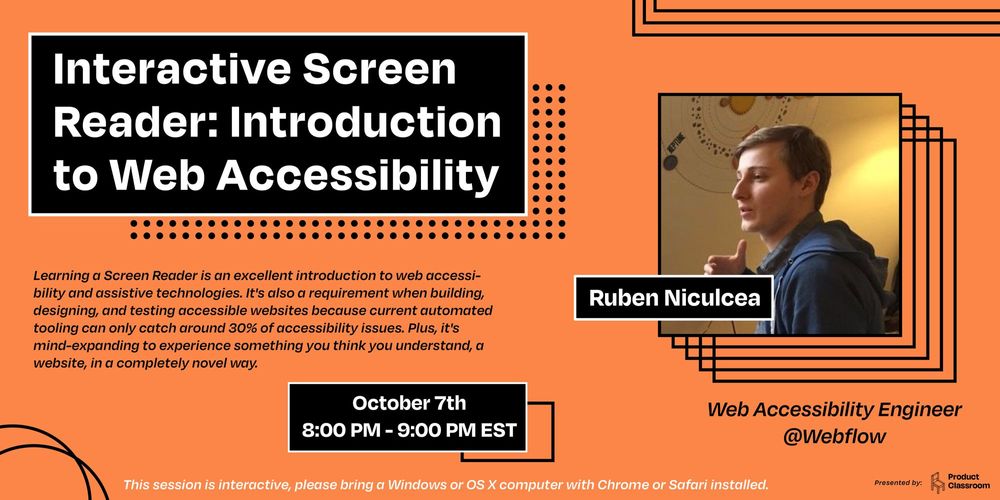

#Website accessibility screen reader how to#
9 Tips on How to Make a Website Accessible for the Blind and Visually Impaired 1. While the following tips aren’t exhaustive, they do cover the common issues people with visual impairments experience when using the Web. We distilled the aforementioned guidelines into a focused set of tips and tricks that other designers can (and should!) use in their design process. Therefore, we provide the following nine tips to improve usability for these people based on Web Content Accessibility Guidelines ( WCAG) and Americans with Disabilities Act ( ADA) guidelines. It would not be fair, nor would it be right, to fail to incorporate designs that offer assistance and ease of use for those who have a visual impairment. Perhaps you’ve heard the term “Legally Blind.” This does not always insinuate total darkness, but the vision impairment is significant enough that one cannot function without personal or technological assistance due to the extreme loss of visible acuity.Īs UX designers, we understand that although the statistical proportion of users who have a visual impairment is small compared to those who do not, we still must account for them during the design phase.

Blindness, by definition, is substantial, uncorrectable loss of vision in both eyes. Those who have vision impairment that is beyond diagnosed low vision are considered blind. Individuals diagnosed with low vision are able to see colors, but struggle with having poor acuity (vision that is not sharp), tunnel vision (seeing only the middle of the visual field), central field loss (seeing only the edges of the visual field), or clouded vision. It is estimated that about 285 million people are visually impaired worldwide: 39 million are blind and 246 million have low vision. A simulation with the Stark plugin of what a blue-yellow colorblind person might see. 5 percent of the female population, so if you’re a Web designer, think about it this way: If 100 people visit your site, statistics would have it that approximately 10 of them are not able to see colors at a normal efficiency. Globally, color blindness affects 8 percent of the male population &. The most common forms of color blindness are deuteranopia, which is a reduced sensitivity to green light, and protanopia, which is a reduced sensitivity to red light. Tim Berners-Lee, W3C director and inventor of the World Wide Web The ProblemĪccording to Prevent Blindness America, 53.2 million Americans aged 45 or older have some form of visual impairment, from mild to severe, and about 18 percent of those affected are “legally blind.” Visual impairments span a range of issues and disabilities, the most prominent of which are color blindness, low vision, and blindness.Ĭolor blindness includes difficulty distinguishing between colors such as between red and green, or between yellow and blue, and sometimes inability to perceive any color whatsoever.

Access by everyone regardless of disability is an essential aspect.” “The power of the web is in its universality. Rather, good web design should accommodate the needs of all users, including people with visual impairments. Users with visual impairments should not have to adapt their behavior in order to effectively accomplish their goals. Shmoe miss out on the information this site offered, but the site owners lost a potential customer, subscriber, and/or an opportunity to share their message. You see, inaccessibility equals exclusion. So what might happen when Joe Shmoe, who is colorblind, cannot read the text on a site because it blends in with the background? Easy: He must move on. Despite all this, people with visual impairments use the web every day to surf, read and write emails, and to do anything else anyone can conceivably do on the internet. For example, it’s not uncommon to see websites that use combinations of background and foreground colors that make pages virtually unreadable for colorblind users.

Much like how years ago, the Americans with Disabilities Act stepped up for those who cannot walk and required wheelchair access to all buildings constructed after 1991, user experience (UX) designers should ensure equal accessibility for all users by designing web-based experiences that can be used, understood, and accessed by people with a diverse range of visual, auditory, cognitive, and physical abilities.īecause web experiences are inherently visual, the web is fraught with sites, tools, and apps that are practically unusable for people with visual impairments. Plainly put, web accessibility enables people with disabilities to perceive, understand, navigate, interact with, and contribute to the web. What is web accessibility and web design for blind users?


 0 kommentar(er)
0 kommentar(er)
